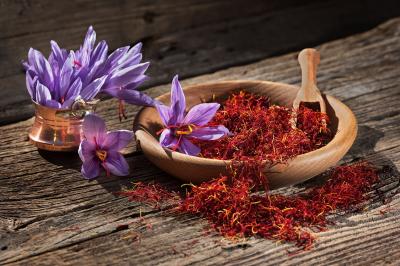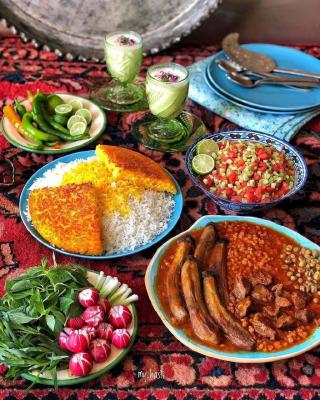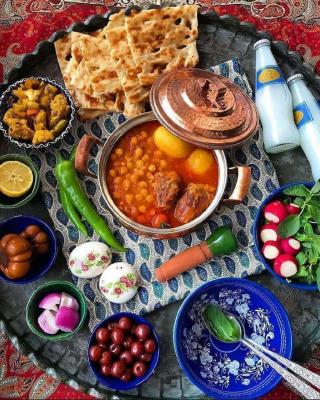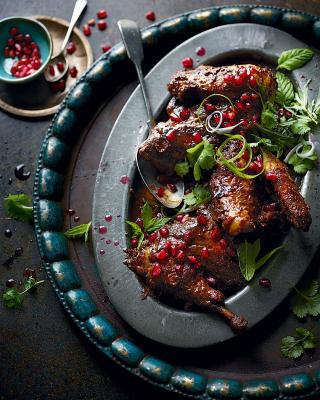The digest of revolving through the history of Persian Cuisine
The history of Persian Cuisine
There is not much left from the Cuisine Culture of the pre-Islamic Iran, and what remains is dedicated to the court of kings and nobles. One of the best remnants is "the Bronze Cup of Arjan" which illustrates the cuisine culture and customs during the different periods. For instance, the book of Altaj is about the life of the kings and the way they ruled the country, but there is a part in a book that belongs to how they had served the food for the court and the culture and customs of celebration in the Sassanid era. The book proves that the culture of Iran remains valuable at least until the fourth and fifth centuries after Islam.
After the fall of the Sasanian Empire, the Arabs acquainted with the Iranian lifestyle. Also, the presence of Iranian in Abbasid palace boosts this acquaintance. Persian Cuisine influenced the three dynasties such as Seljuk, Ilkhanid, and Mughal, which ruled Iran since the 13th century. Also, there are pieces of evidence that prove that foreigners had some effect on Persian Cuisine. The consumption of ghara ghooroot which is a kind of dried black curd that belonged to Turks and using a flavor for making different types of Aush (thick soup/stew) tasty belonged to Central Asia cuisine.
Most of what we know from Persian Cuisine remained from the Safavid Era. Remained letters and handwritings of chefs and the left information from traveler's literary are the main sources for research about Persian cuisine. The left handwritings from the court chefs contain valuable information about eating habits and the luxurious style of serving the food that they had. All kinds of food with polow and kebab were served in large dishes that were shared among two or three people; Persians loved to eat with each other. In the past, people usually used hand instead of cutlery. There were also different kinds of sherbet (Syrup) served in a large bowl usually accompanied by wooden spoons.
Commoners preferred polow, chicken, stew, meat, and simple foods as their usual meal. They liked simple breakfast and they cared to launch it more.
Many travelers told on their itinerary about the luxurious meals Qajar's court. At that time, they were served the foods on adorned dinnerware on the land. Both the courtiers and commoners of Qajar time used to be different in serving foods.
Persian cuisine is known for excessive consumption of rice, slow and low heated style of cooking, the similarity in preparation and recopies, and mild flavor. Rice is an inevitable part of Persian cuisine and in the past, the Northern provinces produce most of the country’s rice. The travelers from the Safavid and Qajar era mentioned that the rice can be certainly fined on Persian's food portions. Jakob Eduard Polak traveler and writer writes that Polow, chelo, and aash are the three main dishes of Iranians that are all made with rice.
Iranian usually served the polow with stew and sometimes uses different kinds of beverage and vegetables such as almond, pistachio, dates, and raisin as a fresh side dish.
Persians cook food slowly and for a long time until all ingredients are cooked well. Even those foods that are fried are made with slow and steady heat. The tastes of Persian meals are famous for its mild flavor and the food is not spicy. Beside all these features, Persians have different and delicious side dishes such as torshi (the pickled vegetables), unique beverages, and vegetables which is attractive for those interested in experience new tastes.
YaldaMedTour is really looking forward to being aware of your ideas and experience, please share them with us.
The digest of revolving through the history of Persian Cuisine The digest of revolving through the history of Persian Cuisine 2020-08-08 08:09:05+3:30
2022-05-09 15:41:54+3:30
There is not much left from the Cuisine Culture of the pre-Islamic Iran, and what remains is dedicated to the court of kings and nobles. One of the best remnants is "the Bronze Cup of Arjan" which illustrates the cuisine culture and customs during the different periods. For instance, the book of Altaj is about the life of the kings and the way they ruled the country, but there is a part in a book that belongs to how they had served the food for the court and the culture and customs of celebration in the Sassanid era. The book proves that the culture of Iran remains valuable at least until the fourth and fifth centuries after Islam.
Persian Food,
Persian Cooking,
Iranian Food,
Iranian Cuisine,
Iranian Cooking,
eyJpdiI6IkxEc0xNVzI2ZXdYZi8rZFQ4UG1Gc1E9PSIsInZhbHVlIjoiVzZqa0tPUGRLK1NHMWFUUjk1K1Y2UT09IiwibWFjIjoiNDczYzBhNjE1MmIzMjI4YTQ4OTYyYzE2YTAxNDk2MTIyMzUwZThmMTYzZWEyZmViNjgwZmExNzBkZmFkMDhiOCIsInRhZyI6IiJ9 eyJpdiI6IlpTMjM0dGtTamZCZGNRM3doa1VHSmc9PSIsInZhbHVlIjoidUxwckV2U01ib0hLM3ozUkVIMXFrdk12bWZiNHd2eC8xUDA3Z2xGN003cz0iLCJtYWMiOiI1ZmE5MzJjODg1NTJhMzk5MzYxYWExNWYyYTY2N2NkODUzYWZmNmE5OTlkMjIwZTQyNjE2NjRlYzI5NDA3NDNhIiwidGFnIjoiIn0=
Author
info@yaldamedtour.com
/en/user-profile/10237
YaldaMedTour
Barajin Salamat Road
+98
Qazvin
Qazvin, Qazvin Province, Iran.
,
info@yaldamedtour.com
2020-08-08 08:09:05+3:30
2022-05-09 15:41:54+3:30
There is not much left from the Cuisine Culture of the pre-Islamic Iran, and what remains is dedicated to the court of kings and nobles. One of the best remnants is "the Bronze Cup of Arjan" which illustrates the cuisine culture and customs during the different periods. For instance, the book of Altaj is about the life of the kings and the way they ruled the country, but there is a part in a book that belongs to how they had served the food for the court and the culture and customs of celebration in the Sassanid era. The book proves that the culture of Iran remains valuable at least until the fourth and fifth centuries after Islam.
Persian Food,
Persian Cooking,
Iranian Food,
Iranian Cuisine,
Iranian Cooking,
eyJpdiI6IkxEc0xNVzI2ZXdYZi8rZFQ4UG1Gc1E9PSIsInZhbHVlIjoiVzZqa0tPUGRLK1NHMWFUUjk1K1Y2UT09IiwibWFjIjoiNDczYzBhNjE1MmIzMjI4YTQ4OTYyYzE2YTAxNDk2MTIyMzUwZThmMTYzZWEyZmViNjgwZmExNzBkZmFkMDhiOCIsInRhZyI6IiJ9 eyJpdiI6IlpTMjM0dGtTamZCZGNRM3doa1VHSmc9PSIsInZhbHVlIjoidUxwckV2U01ib0hLM3ozUkVIMXFrdk12bWZiNHd2eC8xUDA3Z2xGN003cz0iLCJtYWMiOiI1ZmE5MzJjODg1NTJhMzk5MzYxYWExNWYyYTY2N2NkODUzYWZmNmE5OTlkMjIwZTQyNjE2NjRlYzI5NDA3NDNhIiwidGFnIjoiIn0=
Author
info@yaldamedtour.com
/en/user-profile/10237
YaldaMedTour
Barajin Salamat Road
+98
Qazvin
Qazvin, Qazvin Province, Iran.
,
info@yaldamedtour.com
Keywords: Persian Food, Persian Cooking, Iranian Food, Iranian Cuisine, Iranian Cooking,
Copyright © 2026 To YaldaMedTour. All Rights Reserved.
![]()




